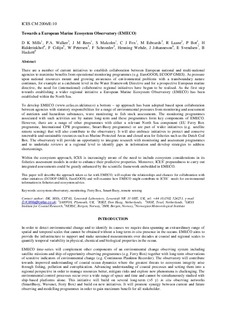| dc.description | agencies to maximise benefits from operational monitoring programmes (e.g. EuroGOOS, ECOOP GMES). As pressure upon national resources mount and growing awareness of environmental problems with a transboundary nature continues, for example at a catchment level in the Water Framework Directive and for a prospective European marine directive, the need for (international) collaborative regional initiatives have begun to be realised. As the first step towards establishing a wider regional initiative a European Marine Ecosystem Observatory (EMECO) has been established within the North Sea.
To develop EMECO (www.cefas.co.uk/emeco) a bottom – up approach has been adopted based upon collaboration between agencies with statutory responsibilities for a range of environmental pressures from monitoring and assessment of nutrients and hazardous substances, wave monitoring to fish stock assessments. The monitoring programmes associated with such activities are by nature long-term and these programmes form key components of EMECO. However, there are a range of other programmes with either a relevant North Sea component (EU Ferry Box programme, International CPR programme, Smart-Buoy programme) or are part of wider initiatives (e.g. satellite remote sensing) that will also contribute to the observatory. It will also embrace initiatives to protect and conserve renewable and sustainable resources such as Marine Protected Areas and closed area for fisheries such as the Dutch Cod Box. The observatory will provide an opportunity to integrate research with monitoring and assessment programmes and to undertake reviews at a regional level to identify gaps in information and develop strategies to address shortcomings.
Within the ecosystem approach, ICES is increasingly aware of the need to include ecosystem considerations in its fisheries assessment models in order to enhance their predictive properties. Moreover, ICES’ preparedness to carry out integrated assessments could be greatly enhanced by the scientific framework embedded in EMECO.
This paper will describe the approach taken so far with EMECO, will explore the relationships and chances for collaboration with other initiatives (ECOOP GMES, EuroGOOS) and will examine how EMECO might contribute to ICES’ needs for environmental information in fisheries and ecosystem advice.
Keywords: ecosystem observatory, monitoring, Ferry Box, Smart-Buoy, remote sensing | no_NO |
